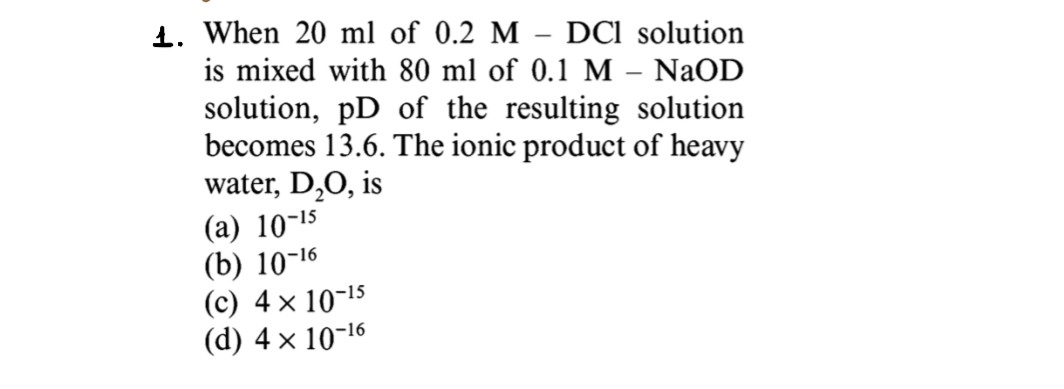- Organic Chemistry
- Aldehydes and Ketones
- Alkyl Halides, Alcohols and ethers
- Amines and other nitrogen compounds
- Aromatic Chemistry
- Carbohydrates, Amino acids, protein, Vitamin and Fat
- Carboxylic acids and its derivatives
- Chemistry in daily life
- General Mechanism in organic compounds
- Hydrocarbons
- Nomenclature and isomerism
102 - Physical Chemistry Questions Answers

Amount of DCl = 4 milimole
Amount of NaOD = 8 milimole
After reaction of acid and base
Amount of NaOD remaining = 4 milimole
Total volume = 100 ml = 0.1 lit
so [OD] =4*10-3/0.1=4*10-2 (1)Given pD = 13.6so log[D+] =-13.6= ¯14.4⇒[D+] =2.5*10-14 (2)Now solve
Q.WRITE CELL RECTION OF THE FOLLOWING- .{1} ZN | ZN2+ || cu2+ |cu {2} PT {H2} | HCL || CL2{PT}
Zn -----------> Zn++ + 2e-
Cu++ + 2e- -----------> Cu
H2 --------> 2H+ + 2e-
Cl2 + 2e- --------> 2Cl-
one molar solution of sulphuric acid is equal to 2N. how???
sir as we know for sul.acid n factor = 2
so normality will be = 2xM thus M = N/2
but ans is 2N so plz give account of it .
molarity = 1
and N = nM = 2(1) = 2
hence it is clear
If ionic product of water is Kw = 10-6 at 4°C, then a solution with pH = 7.5 at 4°C will
(i) turns blue litmus red
(ii) turns red litmus blue
(ii) Be neutral to litmus
question is not appropriate because for given Kw , [H+] will be 10-3 and max. pH will be 6 and the question is asking about a solution of pH 7.5 which is out of limit
but if it is considered as a correct question then answer will be (ii)
N2 + O2 = 2NO . Equilibrium constant Kc = 2 . Degree of dissociation is
(i) 1/1-√2 (ii) 1/1+√2 (iii) 2/1-√2
N2 + O2 = 2NO
1 1 0
1-x 1-x 2x
so by formula Kc = (2x)2 / (1-x)(1-x)
now solve for x
In the equilibrium SO2Cl2 = SO2 + Cl2 at 2000K and 10 atm pressure , % Cl2 = % SO2 = 40 (by volume) . Then what is the value of Kp?
SO2Cl2 = SO2 + Cl2
100 0 0
20 40 40
2 atm 4 atm 4 atm
now calculate Kp
0.2 mole of N2 and 0.6 mole of H2 react to give NH3 and 40 % of reactant mixture is decreased , according to the equation,
N2 (g) + 3H2 (g) = 2NH3 (g) at constant temperature and pressure. Then the ratio of the final volume to the initial volume of gases is
N2 (g) + 3H2 (g) = 2NH3 (g)
0.2 0.6 0
0.2-x 0.6-3x 2x
according to the given condition 4x = 0.8*40/100 = 0.32
so x = 0.08
now solve
1 mole of A , 1.5 mole of B and 2 moles of C are taken in a vessel volume one litre. At equilibrium concentration of C is 0.5 mole/L. Equilibrium constant for the reaction
A (g) + B (g) = C (g)
A (g) + B (g) = C (g)
1 1.5 2
1-x 1.5-x 2+x
according to the given condition 2+x = 0.5 so x = -1.5
now calculate Kc
The Ksp for a sparingly soluble Ag2CrO4 is 4 x 10-12. The molar solubility of the salt is
Ag2CrO4 -------------> 2Ag + CrO4
s 0 0
2s s
so Ksp = (2s)2 s = 4s3
now solve
A 0.1N solution of sodium bicarbonate has a pH value of
Please submit complete question, Ka should be given with percentage of ionisation
